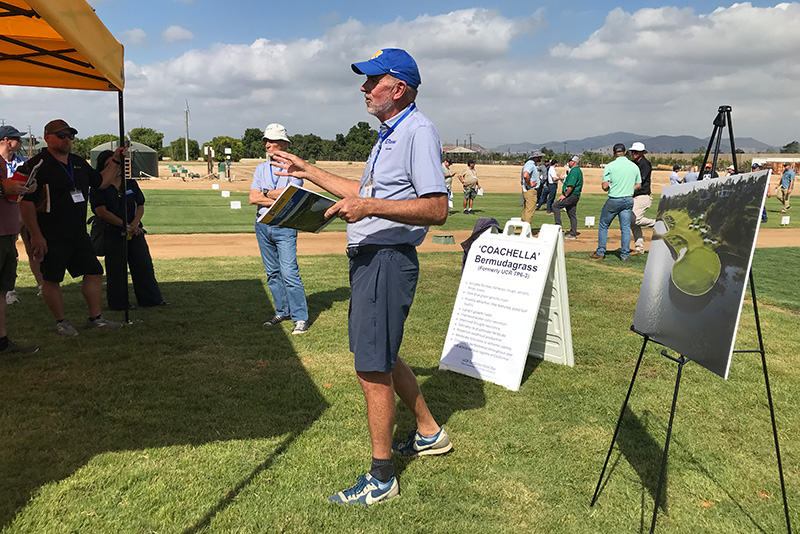
Jim Baird, Ph.D., a faculty member in University of California-Riverside's Turfgrass Breeding & Genetics Program, describes the benefits of Coachella hybrid bermudagrass at UCR's Turfgrass and Landscape Research Field Day. Photo by Darrell J. Pehr
With its bluish-green color, improved winter color retention and superior drought resistance, the hybrid bermudagrass Coachella was on center stage at the Sept. 11 Turfgrass and Landscape Research Field Day at the University of California-Riverside.
Faculty members in the UCR Turfgrass Breeding & Genetics Program — Jim Baird, Ph.D., and Adam Lukaszewski, Ph.D. — outlined the benefits of the new cultivar for dozens of attendees at the annual event.
The project that developed Coachella started in 2012 as part of a program intended to develop new bermudagrass and kikuyugrass cultivars with improved winter color retention, drought resistance and turf quality traits. Initial work led to the development of 350 hybrids, said Lukaszewski, from which Coachella and one other were chosen. The other hybrid is similar and has also been patented but not yet named or released.
The first commercial installation of Coachella was at the Farms Golf Club in Rancho Santa Fe, Calif., with about 65 acres planted among tees, fairways and rough. The course is scheduled to reopen in October. A second large-scale installation is expected to begin in the fall at Big Canyon Country Club in Newport Beach, Calif.
“We’re very proud of that,” Baird said, “but I don’t want you to think of this as just a golf course grass. It has uses in other areas … lawns, athletic fields, etc., so we’re excited about that.”
Coachella also was selected for shortened winter dormancy in Riverside. Researchers noted that turf quality of Coachella is like or better than the existing or latest bermudagrass cultivar releases. Coachella also has an upright growth habit.
“That upright growth habit, especially in the rough, seems to help the ball sit up for the golfer,” Baird said. “Bermudagrass can be pretty gnarly as a rough. You can’t get it too tall. The ball just sinks.”
Baird noted that color retention — a key selection criterion in the breeding process — is improved, but location also plays a role in how long the grass will retain color.
“It’s not going to be green everywhere for everyone, but the closer you get to the coast, where the Pacific Ocean moderates the temperature, the more chance that Coachella is going to stay green year-round,” Baird said. Longer or year-round color retention helps turf managers who intend to avoid reseeding in winter.
The researchers also noted that Coachella possesses better drought tolerance than most cultivars, especially when irrigation is not applied.
“Among bermudagrass cultivars, Coachella has moderate tolerance to extreme, worst-case scenario irrigation and soil salinity,” they reported. “Recently, Coachella was discovered to be more tolerant to Roundup (glyphosate) herbicide, which can be potentially used as another chemical tool for winter weed control.” While Coachella is not immune to flowering in springtime, the process is typically less obtrusive and shorter-lived that other, similar hybrid bermudagrasses.
A final strength Baird pointed out is the consistency of the grass, which is important to turf managers. When compared to similar bermudagrasses, “Coachella is just more of a consistent performer from month to month, from year to year,” he said.
West Coast Turf is the exclusive licensee for Coachella in the U.S. and Mexico.
Darrell J. Pehr is GCM’s science editor